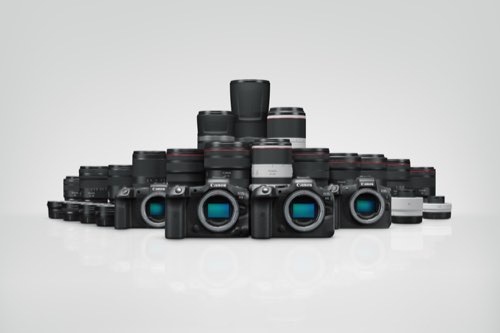Covering standard, wide-angle, and often also medium telephoto focal ranges, a standard zoom lens is highly versatile. It’s probably the first type of lens you ever owned, and also many photographers’ most frequently used lens. Canon has different variations of RF mount standard zoom lenses to cater to diverse user needs. Whether you’re researching on which first lens to get or looking at an upgrade, read on to learn more about your options!
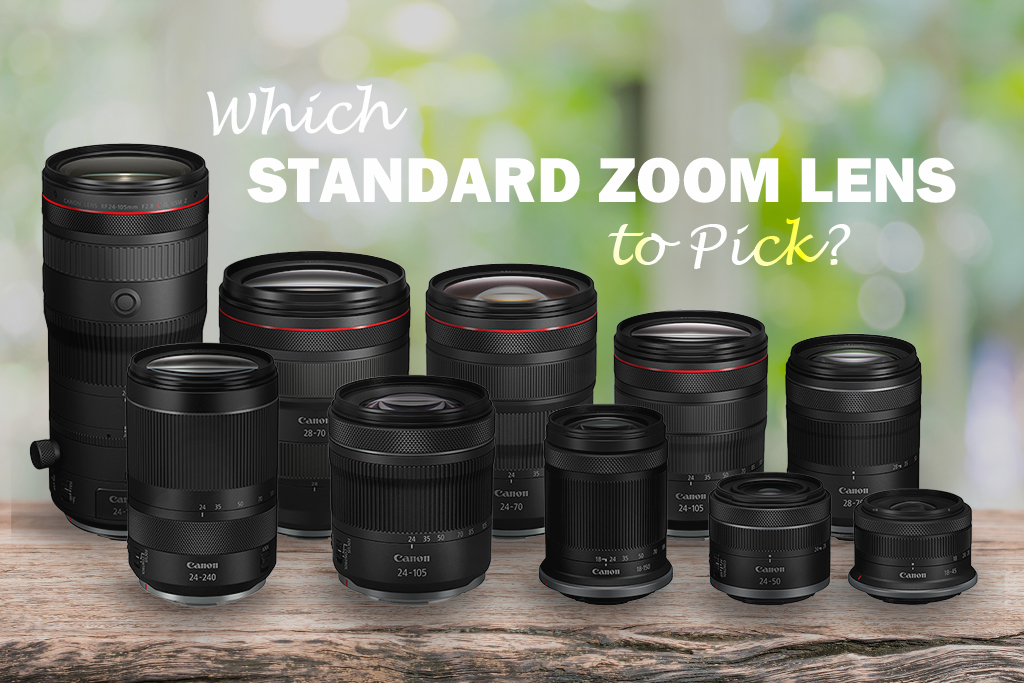
First question: What do you prioritise?
There must be a reason you’re planning to get a standard zoom lens other than the one that comes with a camera kit.
Do you want…
- Something small, compact, and easy to use for handheld vlogs or a small gimbal?
- Better bokeh and low light performance?
- The best versatility for professional shoots?
- Exceptional image quality?
- To be able to zoom in without the maximum aperture changing?
To many, the perfect lens would be all of the above. However, it’s not realistically possible to create a lens with all these qualities.
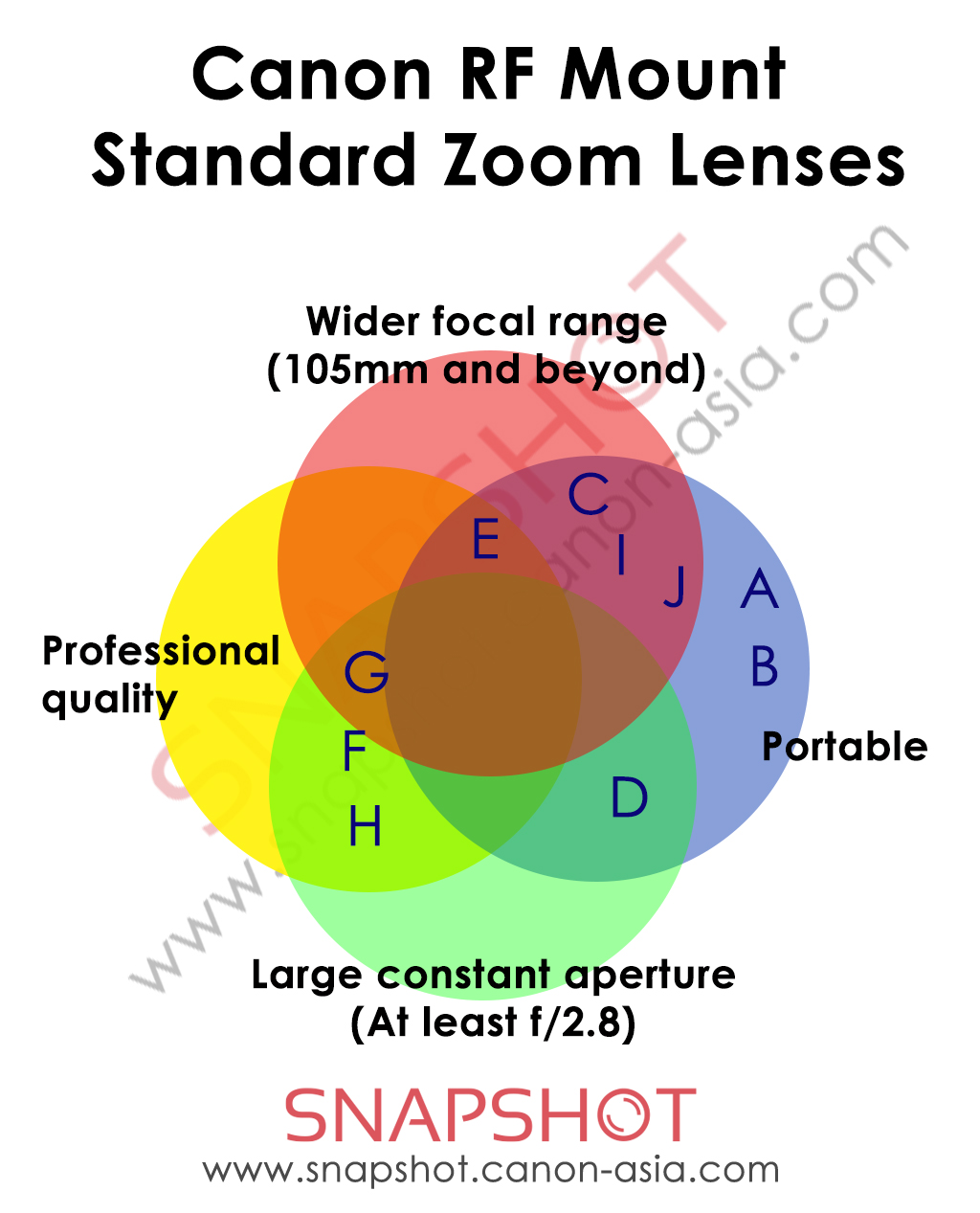
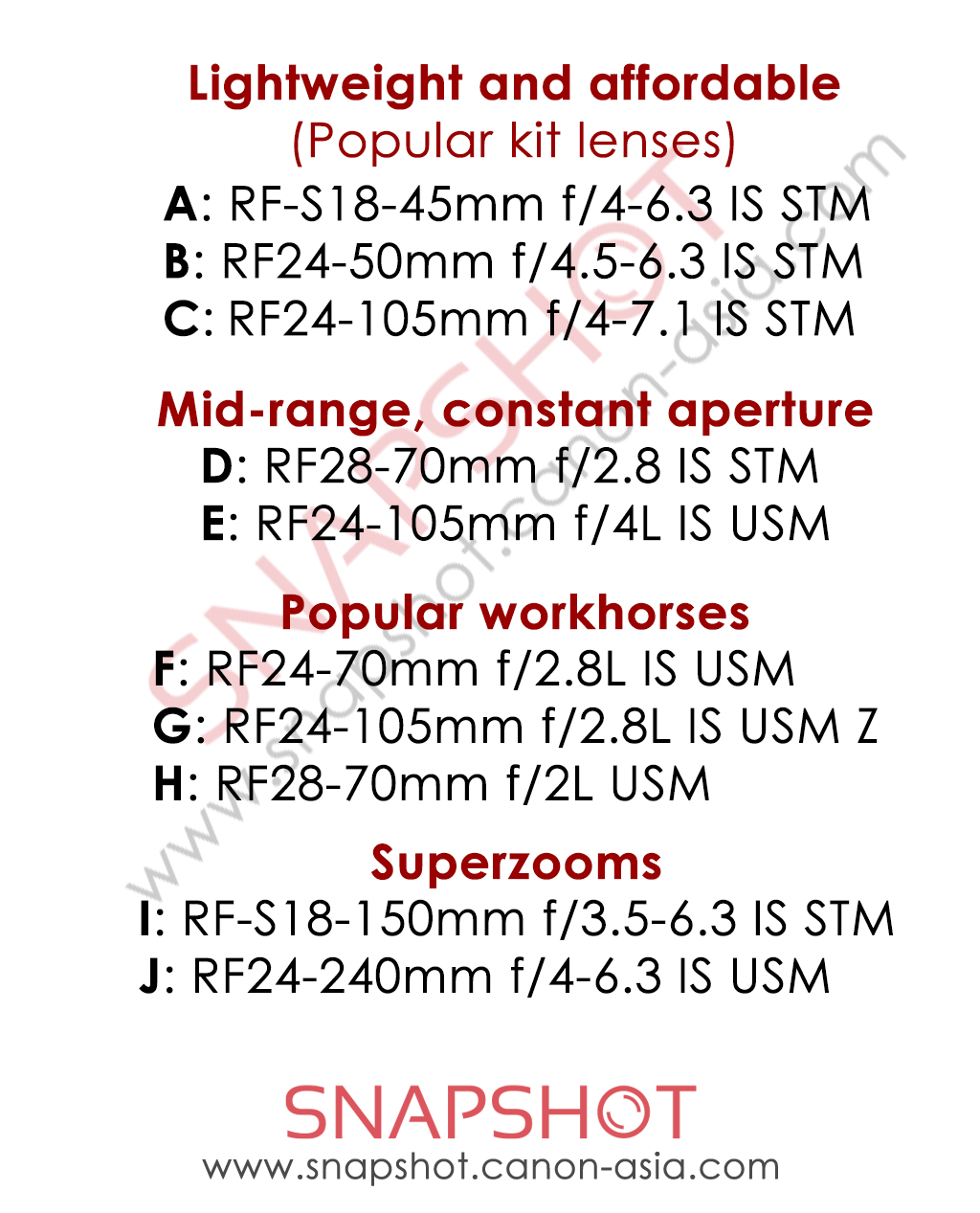
Here are our suggestions based on popular user needs—it should give more clarity on which lens(es) you should be looking at!
Click on the links to learn more and make a better decision. For an overview and TL;DR summary of all the lenses, go to the last section.
| What you want | Suggestions |
| Tiny and lightweight | RF-S18-45mm f/4.5-6.3 IS STM RF24-50mm f/4.5-6.3 IS STM |
| Constant maximum aperture | RF28-70mm f/2.8 IS STM RF24-105mm f/4L IS USM RF24-70mm f/2.8L IS USM RF24-105mm f/2.8L IS USM Z RF28-70mm f/2L USM |
| Best low light performance | RF28-70mm f/2.8 IS STM RF24-70mm f/2.8L IS USM RF24-105mm f/2.8L IS USM Z RF28-70mm f/2L USM |
| Zoom to 105mm and beyond | RF-S18-150mm f/3.5-6.3 IS STM RF24-240mm f/4-6.3 IS USM RF24-105mm f/4-7.1 IS STM RF24-105mm f/4L IS USM RF24-105mm f/2.8L IS USM Z |
| More zoom + constant maximum aperture | RF24-105mm f/4L IS USM RF24-105mm f/2.8L IS USM Z |
| Top-notch optical quality The largest maximum aperture possible on a full-frame standard zoom |
RF28-70mm f/2L USM |
| Support for motorized zooming | RF24-105mm f/2.8L IS USM Z (with Power Zoom Adapter PZ-E2, sold separately) |
| Professional-grade build and quality | RF24-105mm f/4L IS USM RF24-70mm f/2.8L IS USM RF24-105mm f/2.8L IS USM Z RF28-70mm f/2L USM |
Smallest and lightest
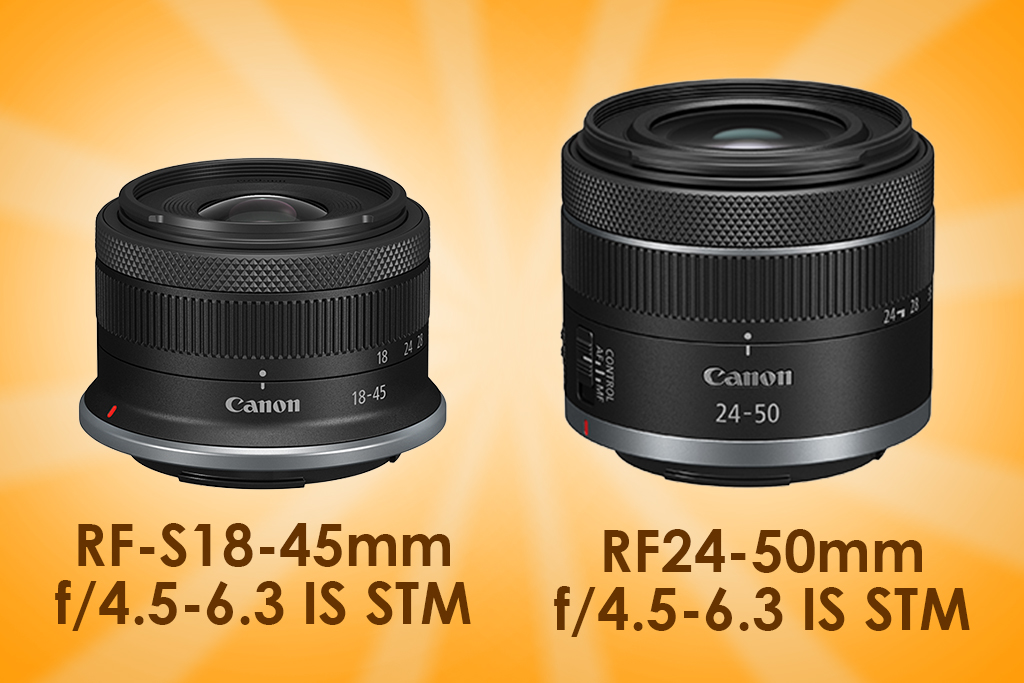
- RF-S18-45mm f/4.5-6.3 IS STM
- RF24-50mm f/4.5-6.3 IS STM
Both lenses are lightweight and very compact—perfect for casual everyday shooting, handheld vlogging, or use on a gimbal. The RF24-50mm f/4.5-6.3 IS STM is slightly larger and heavier, reflecting the larger glass required to cater to a full-frame camera sensor.
| Lens | Dimensions (approx.) (When retracted) |
Weight (approx.) |
| RF-S18-45mm f/4.5-6.3 IS STM | φ69.0 × 44.3mm | 130g |
| RF24-50mm f/4.5-6.3 IS STM | φ69.6 × 58.0mm | 210g |
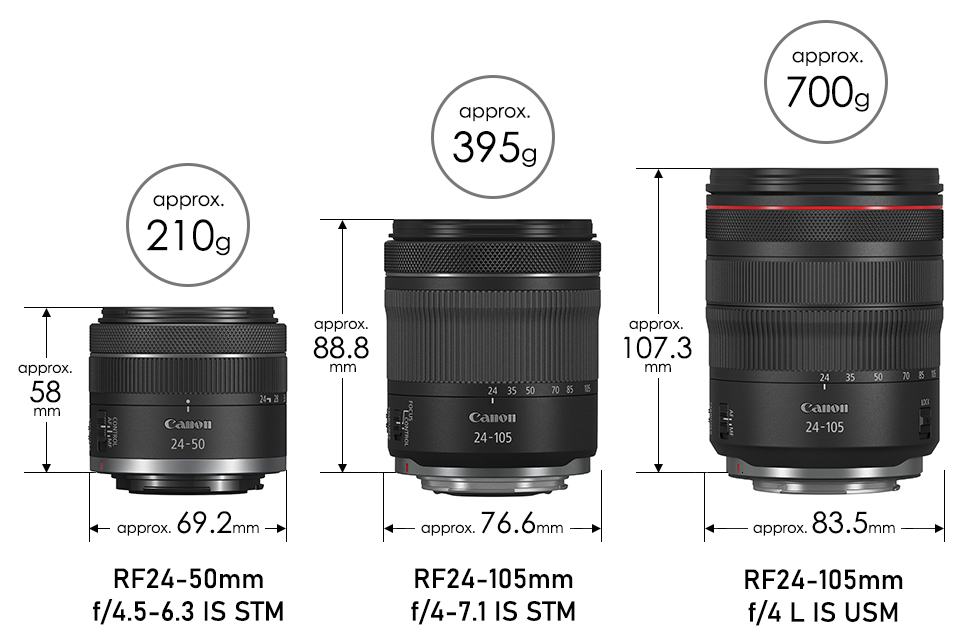
The RF24-50mm f/4.5-6.3 IS STM is substantially smaller than the nearest similar full-frame RF standard zoom lenses.
Differences between the two lenses
RF-S vs. RF
“RF-S” lenses are designed for the smaller APS-C sensor. This accounts for the lighter weight, too, as smaller glass elements can be used. You must factor in the 1.6x APS-C crop factor to get an idea of the actual coverage: see below.
| Lens | Coverage on an APS-C camera (Full-frame equivalent) |
Coverage on a full-frame camera |
| RF-S18-45mm f/4.5-6.3 IS STM | 28.8-72mm | 28.8-72mm* |
| RF24-50mm f/4.5-6.3 IS STM | 38.4-80mm | 24-50mm |
* Images will have fewer megapixels.
The RF-S18-45mm f/4.5-6.3 IS STM can be used on full-frame EOS R series cameras, but the camera will go into 1.6x crop mode. The resulting images have the same angle of view as on an APS-C camera, but fewer megapixels than your camera’s full resolution.
Better low light performance/bokeh
Better low light performance/bokeh
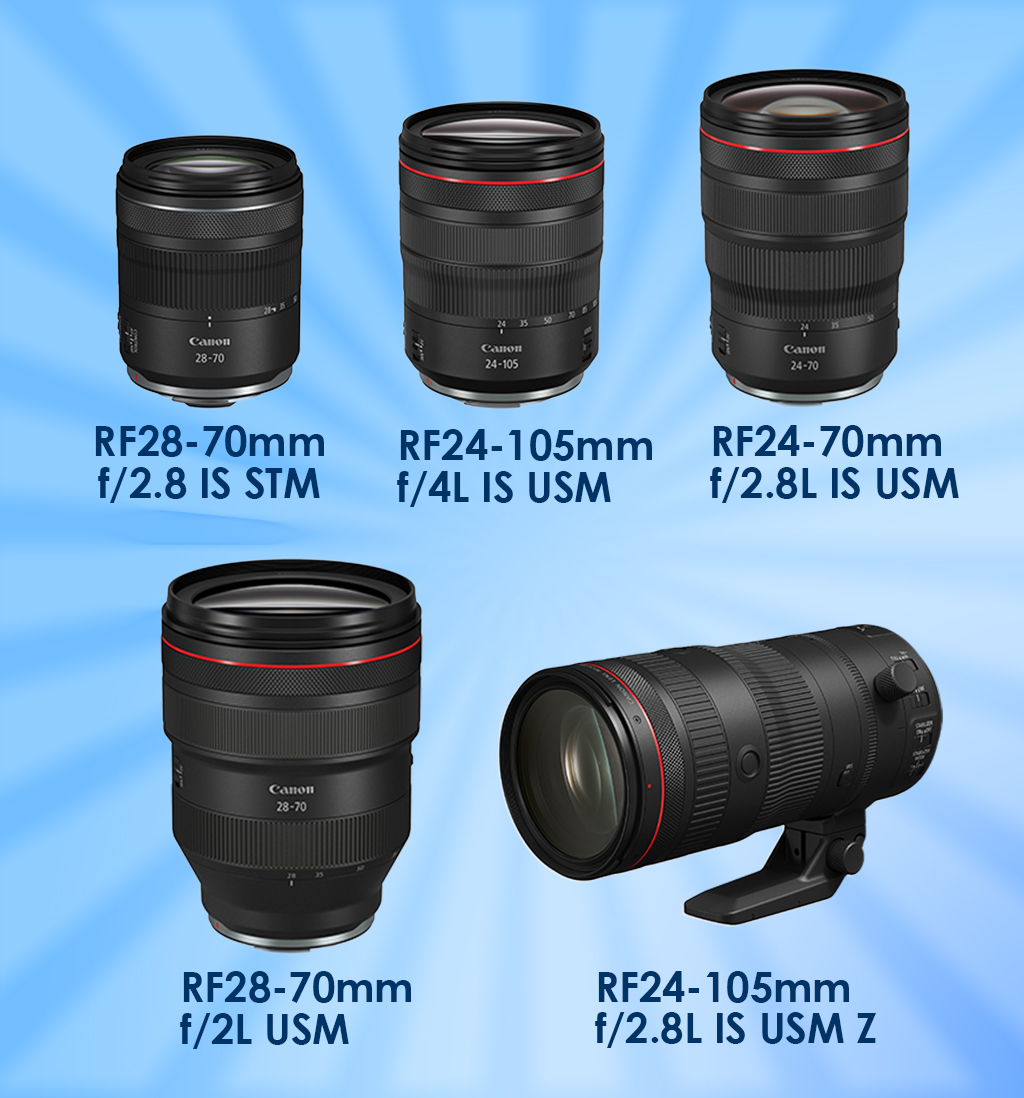
- RF28-70mm f/2.8 IS STM
- RF24-105mm f/4L IS USM
- RF24-70mm f/2.8L IS USM
- RF28-70mm f/2L USM
- RF24-105mm f/2.8L IS USM Z
Most people upgrading their kit lens will upgrade to a constant aperture zoom lens, as it lets them keep the same exposure settings even after zooming in. If you’re shooting moving subjects in low light, that could mean the difference between motion blur and a sharp shot that freezes action!
For example, on the RF24-105mm f/4L IS USM, you can use f/4 even at the 105mm end. On the RF24-105mm f/4-7.1 IS STM, your maximum aperture would be f/7.1 instead, and you’d have to adjust the shutter speed/ISO speed accordingly.
Which constant aperture zoom to pick?
The RF lineup currently has 5 constant aperture standard zoom lenses, all designed for full-frame cameras. Here are some things to consider as you decide.
Portability
Do your shoots involve lots of walking around? If portability matters, consider either the RF28-70mm f/2.8 IS STM or RF24-105mm f/4L IS USM.
The RF28-70mm f/2.8 IS STM is Canon’s most compact f/2.8 standard zoom lens, whereas the RF24-105mm f/4L IS USM balances a wider zoom range, constant aperture, portability, and professional-grade quality.
| Lens | Dimensions (approx. diameter x length) |
Weight (approx.) |
| RF28-70mm f/2.8 IS STM | φ76.5 x 92.2mm (retracted) | 495g |
| RF24-105mm f/4L IS USM | φ83.5 x 107.3mm (retracted) | 700g |
| RF24-70mm f/2.8L IS USM | φ88.5 x 125.7mm (retracted) | 900g |
| RF24-105mm f/2.8L IS USM Z | φ88.5 x 199mm (fixed barrel) | 1,330g |
| RF28-70mm f/2L USM | φ103.8 x 139.8mm (fixed barrel) | 1,430g |
Optical quality and build
Do you frequently shoot in backlight, or desire the sharpest, cleanest images possible even when shooting wide-open?
The lenses with “L” in their name are professional-grade lenses, and boast superior optics with a more robust build quality. They also come with a bundled lens hood.
But even then, some L-lenses are designed for superiority.
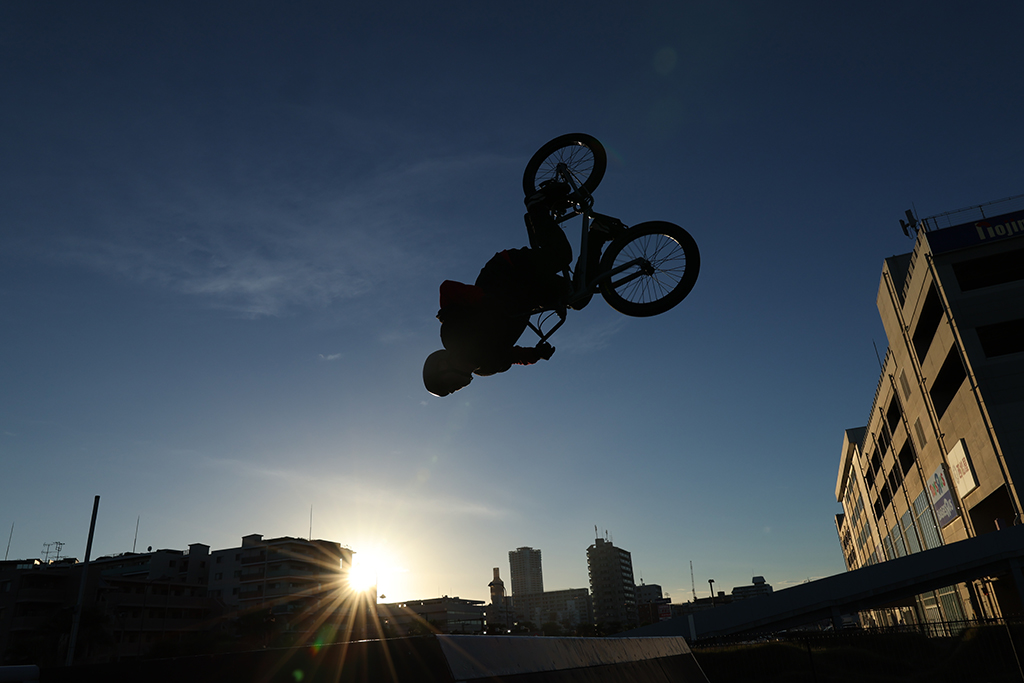
RF24-105mm f/2.8L IS USM Z + EOS R3
High-end lenses are designed to ensure clean and clear images with minimal ghosting and flaring, even when shooting into intense light.
The best of them all
The RF28-70mm f/2L USM is renowned for its exceptional sharpness throughout its zoom range and prime-lens-like performance, even at f/2. That also explains its price tag and size.
The RF24-105mm f/2.8L IS USM Z is a first-of-its-kind game-changing photo-video hybrid that combines top-notch optical quality with range and functionality.
RF24-105mm f/4L IS USM vs. RF28-70mm f/2.8 IS STM?
At the other end of the spectrum are the RF24-105mm f/4L IS USM and RF28-70mm f/2.8 IS STM. which have similar image quality. The key differences between them are focal range, maximum aperture, and body design. The RF28-70mm f/2.8 IS STM employs a different type of anti-flare and -ghosting coating, has no anti-smudge fluorine coating on the front and rear lens surface, and no weather-sealing around the switches.
Focal range/wide-angle end
If you’re torn between lenses with different focal ranges, here’s some food for thought that should make the decision easier:
- Perspective distortion is more visible at 24mm; 28mm is sufficient for most portrait shoots.
- A longer focal length also contributes to blurrier bokeh.
- Would it affect your shoot significantly if you need to switch lenses to access focal lengths in the “missing range”?
- Which is more important: focal range, maximum aperture, or mobility?
It all depends on your needs, preferences, and shooting style.
Which maximum aperture?
The widest possible maximum aperture will give the most flexibility. If the RF28-70mm f/2L USM isn’t feasible for you, there are three different f/2.8 options. Find the best balance between your budget and needs. Consider the RF24-105mm f/4L IS USM if range and mobility are higher priority.

EOS R5 + RF24-105mm f/2.8L IS USM Z @ 105mm, f/2.8
Long focal length + large maximum aperture = beautiful, intense bokeh.
Image stabilisation?
The RF28-70mm f/2L USM is the only lens on the list with no image stabilisation, but that shouldn’t be a problem if you’re using it with Speedlites, studio strobes, on a camera with In-Body IS, or with a shutter speed fast enough to avoid camera shake.
Would you be shooting video with it?
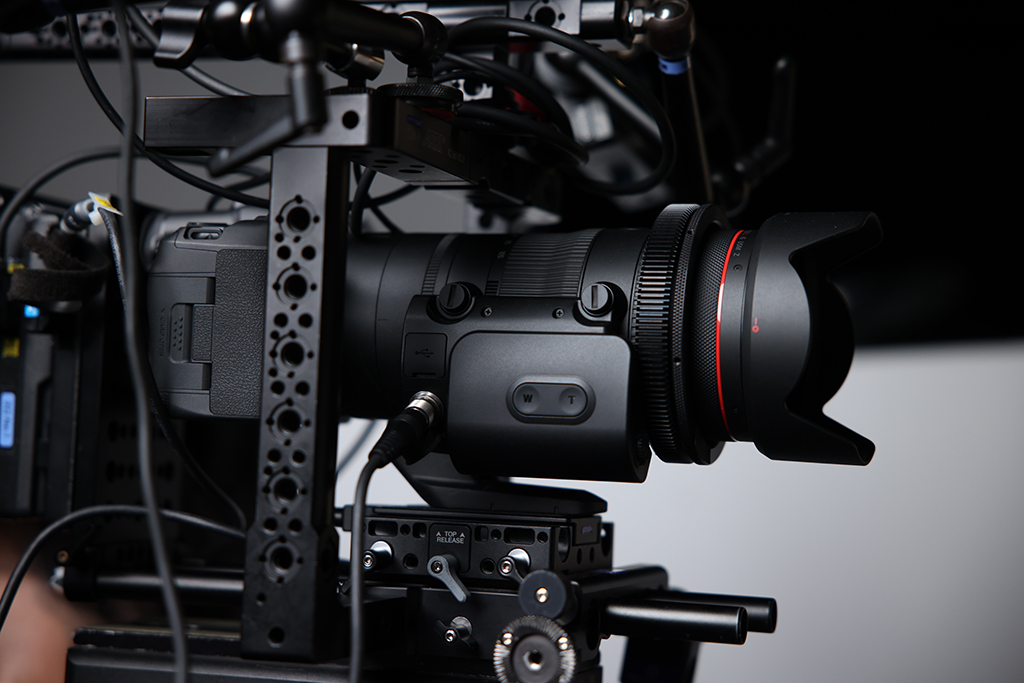
The RF24-105mm f/2.8L IS USM Z can be used with the Power Zoom Adapter PZ-E2 (sold separately) to achieve smooth motor-powered zooming. It also has a clickless aperture ring for seamless and silent aperture changes during video shooting.
FAQ: Should I get a full-frame lens for my APS-C camera?
FAQ: Should I get a full-frame RF lens for my APS-C camera?
If you use an APS-C EOS R series camera like the EOS R7, EOS R10, or EOS R50, you might be considering a full-frame standard zoom lens for the following reasons:
- More options
- So you can use the same lens with a future full-frame camera
Remember: you’ll lose wide-angle coverage
When using a full-frame RF lens on an APS-C camera, you’ll gain more reach but lose wide-angle coverage due to the 1.6x APS-C crop.
| If your full-frame lens starts at... | It looks like this on your APS-C camera |
| 24mm | 38.4mm |
| 28mm | 44.8mm |


Whether that is a significant drawback depends on the situation and your shooting style.
It won’t be a disadvantage if:
- You usually shoot outdoors where there’s lots of space to move back.
- You mainly use your standard zoom lens for portraiture, product photography, or other scenes that tend to use the “standard” (40-60mm equivalent) focal ranges.
It could be a disadvantage if:
- You want an all-rounder lens that can also handle selfies, interiors, and tight spaces.
- You frequently use the 18-24mm range on your current kit lens.
If you tend to shoot with the wider ranges of your existing kit lens and reach isn’t a concern, consider getting a full-frame wide-angle zoom lens instead. You'll get to enjoy their stunning ultra-wide-angle perspectives when you get your full-frame camera!
Some recommendations below.
| Lens | Coverage on an APS-C camera (Full-frame equivalent) |
| RF16-28mm f/2.8 IS STM | 25.6-44.8mm |
| RF14-35mm f/4L IS USM | 22.4-56mm |
| RF15-35mm f/2.8L IS USM | 24-56mm |
Standard zoom lenses with longer reach
Standard zoom lenses with longer reach
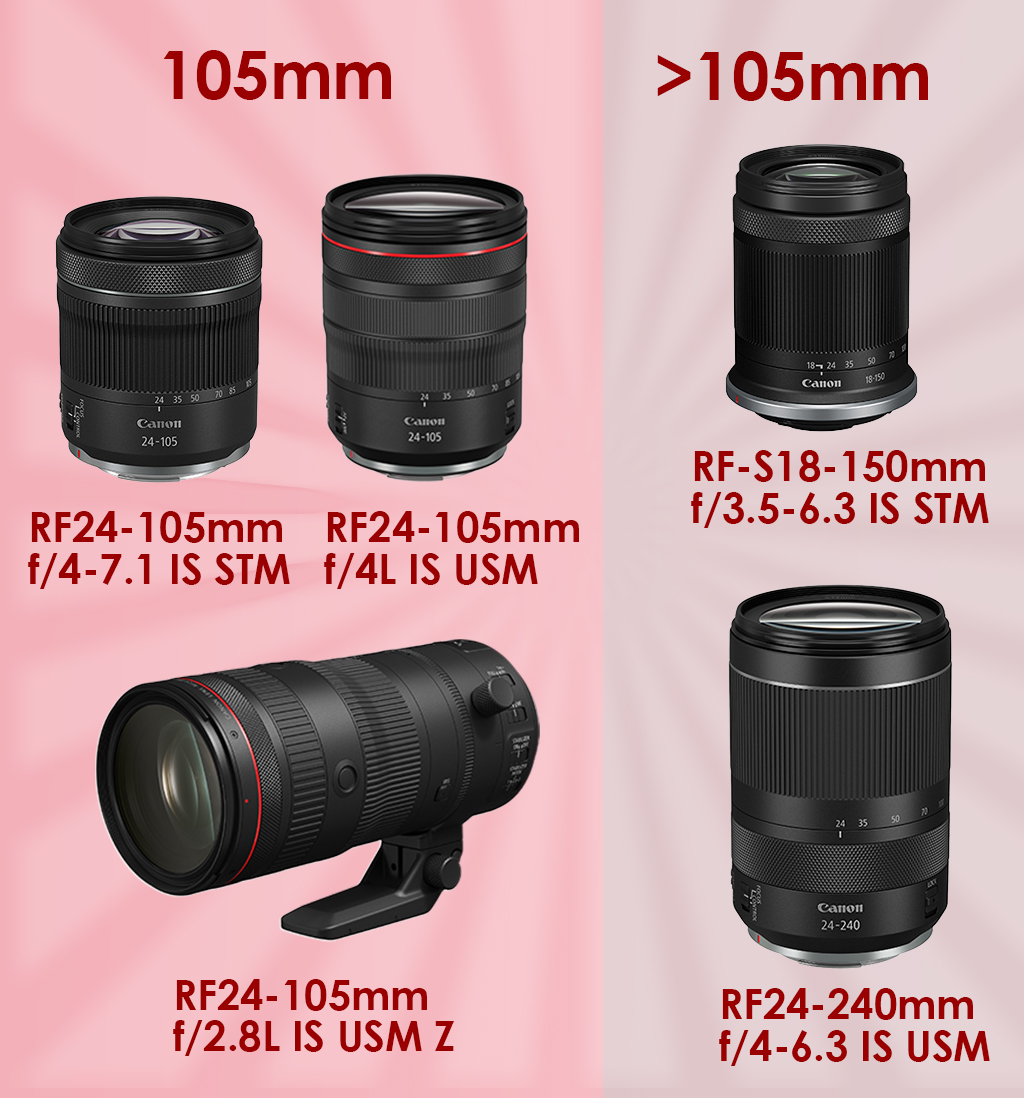
- RF-S18-150mm f/3.5-6.3 IS STM
- RF24-240mm f/4-6.3 IS USM
- RF24-105mm f/4-7.1 IS STM
- RF24-105mm f/4L IS USM
- RF24-105mm f/2.8L IS USM Z
| Lens | Coverage on an APS-C camera (Full-frame equivalent) |
Coverage on a full-frame camera |
| RF-S18-150mm f/3.5-6.3 IS STM | 28.8-240mm | 28.8-240mm* |
| RF24-105mm f/4L IS USM RF24-105mm f/4-7.1 IS STM RF24-105mm f/2.8L IS USM Z |
38.4-168mm | 24-105mm |
| RF24-240mm f/4-6.3 IS USM | 38.4-384mm | 24-240mm |
* Images will have fewer megapixels.
The RF-S18-150mm f/3.5-6.3 IS STM and RF24-240mm f/4-6.3 IS STM are considered “superzoom” lenses due to their wide focal range and extra-long reach. They have longer barrels than the other standard zoom lenses with smaller focal ranges, but are ideal if you want a travel-friendly lens that does it all!
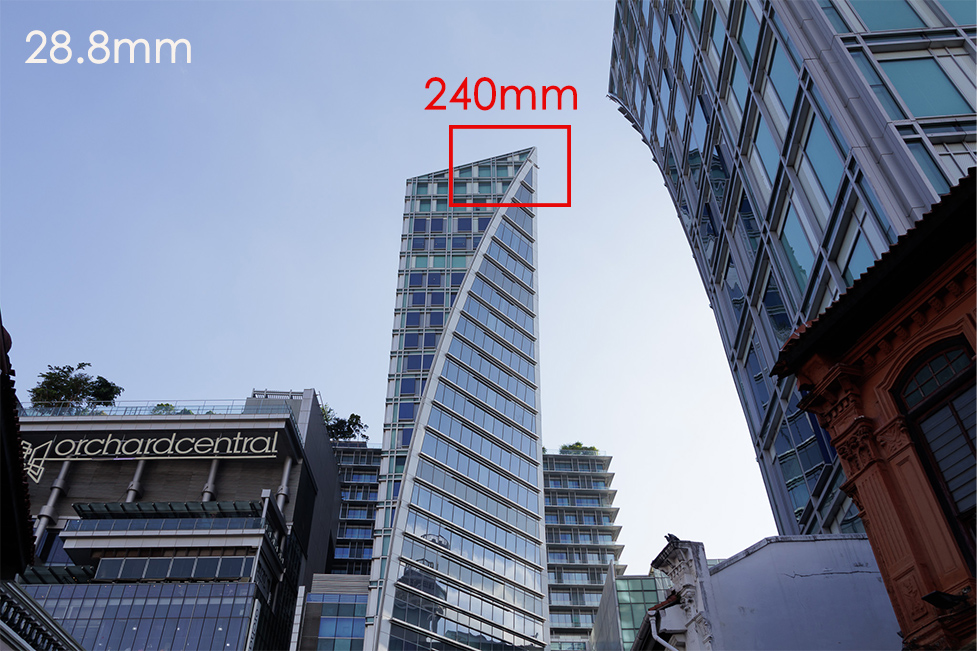
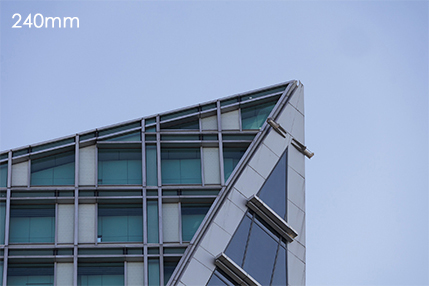
Shot on the RF-S18-150mm f/3.5-6.3 IS STM from the same position. A superzoom lens lets you go from wide to zoomed in and everything in between without changing lenses.
Go for a constant aperture 24-105mm lens for low light shooting
As both superzoom lenses are variable aperture lenses, you might notice their limitations if you frequently shoot indoors or in low light. Consider the RF24-105mm f/4L IS USM and RF24-105mm f/2.8L IS USM Z. 105mm is enough for visible compression and detailed close-ups of architecture across the road.

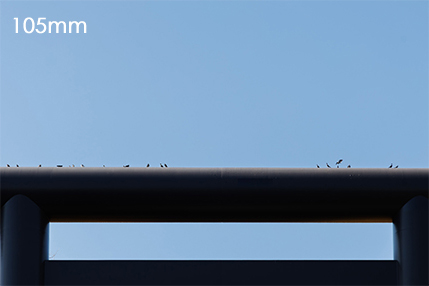
Shot with the RF24-105mm f/4L IS USM from the same position. A 24-105mm lens is sufficient for telling different stories of the same place, and even for close-ups of small objects like flowers and plants if they are no more than a few steps away.
Canon’s standard zoom lenses at a glance
Canon’s RF standard zoom lenses at a glance

RF28-70mm f/2L USM
Exceptional optical quality

RF24-70mm f/2.8L IS USM
Classic professional standard zoom

RF24-105mm f/2.8L IS USM Z
Stellar speed and range with power zoom support

RF28-70mm f/2.8 IS STM
f/2.8 constant aperture zoom on a budget

RF24-105mm f/4L IS USM
Well-balanced professional standard

RF24-105mm f/4-7.1 IS STM
Smallest and lightest 24-105mm

RF24-50mm f/4.5-6.3 IS STM
Overall smallest and lightest (full-frame version)

RF-S18-45mm f/4-6.3 IS STM
Overall smallest and lightest (APS-C version)

RF24-240mm f/4-6.3 IS USM
Jack of all trades (full-frame version)

RF-S18-150mm f/3.5-6.3 IS STM
Jack of all trades (APS-C version)






















